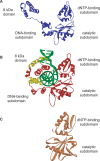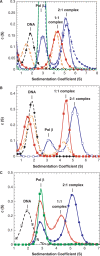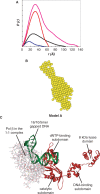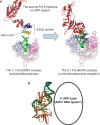Solution structures of 2 : 1 and 1 : 1 DNA polymerase-DNA complexes probed by ultracentrifugation and small-angle X-ray scattering
- PMID: 18084022
- PMCID: PMC2241917
- DOI: 10.1093/nar/gkm1101
Solution structures of 2 : 1 and 1 : 1 DNA polymerase-DNA complexes probed by ultracentrifugation and small-angle X-ray scattering
Abstract
We report small-angle X-ray scattering (SAXS) and sedimentation velocity (SV) studies on the enzyme-DNA complexes of rat DNA polymerase beta (Pol beta) and African swine fever virus DNA polymerase X (ASFV Pol X) with one-nucleotide gapped DNA. The results indicated formation of a 2 : 1 Pol beta-DNA complex, whereas only 1 : 1 Pol X-DNA complex was observed. Three-dimensional structural models for the 2 : 1 Pol beta-DNA and 1 : 1 Pol X-DNA complexes were generated from the SAXS experimental data to correlate with the functions of the DNA polymerases. The former indicates interactions of the 8 kDa 5'-dRP lyase domain of the second Pol beta molecule with the active site of the 1 : 1 Pol beta-DNA complex, while the latter demonstrates how ASFV Pol X binds DNA in the absence of DNA-binding motif(s). As ASFV Pol X has no 5'-dRP lyase domain, it is reasonable not to form a 2 : 1 complex. Based on the enhanced activities of the 2 : 1 complex and the observation that the 8 kDa domain is not in an optimal configuration for the 5'-dRP lyase reaction in the crystal structures of the closed ternary enzyme-DNA-dNTP complexes, we propose that the asymmetric 2 : 1 Pol beta-DNA complex enhances the function of Pol beta.
Figures







Similar articles
-
DNA polymerase X of African swine fever virus: insertion fidelity on gapped DNA substrates and AP lyase activity support a role in base excision repair of viral DNA.J Mol Biol. 2003 Mar 7;326(5):1403-12. doi: 10.1016/s0022-2836(03)00019-6. J Mol Biol. 2003. PMID: 12595253
-
How a low-fidelity DNA polymerase chooses non-Watson-Crick from Watson-Crick incorporation.J Am Chem Soc. 2014 Apr 2;136(13):4927-37. doi: 10.1021/ja4102375. Epub 2014 Mar 21. J Am Chem Soc. 2014. PMID: 24617852
-
Solution structure of the lyase domain of human DNA polymerase lambda.Biochemistry. 2003 Aug 19;42(32):9564-74. doi: 10.1021/bi034298s. Biochemistry. 2003. PMID: 12911298
-
Fidelity mechanisms of DNA polymerase beta.Prog Nucleic Acid Res Mol Biol. 2003;73:137-69. doi: 10.1016/s0079-6603(03)01005-5. Prog Nucleic Acid Res Mol Biol. 2003. PMID: 12882517 Review.
-
History of DNA polymerase β X-ray crystallography.DNA Repair (Amst). 2020 Sep;93:102928. doi: 10.1016/j.dnarep.2020.102928. DNA Repair (Amst). 2020. PMID: 33087265 Free PMC article. Review.
Cited by
-
Transcriptome Sequencing Reveals Tgf-β-Mediated Noncoding RNA Regulatory Mechanisms Involved in DNA Damage in the 661W Photoreceptor Cell Line.Genes (Basel). 2022 Nov 17;13(11):2140. doi: 10.3390/genes13112140. Genes (Basel). 2022. PMID: 36421815 Free PMC article.
-
Mismatched base-pair simulations for ASFV Pol X/DNA complexes help interpret frequent G*G misincorporation.J Mol Biol. 2008 Dec 31;384(5):1086-97. doi: 10.1016/j.jmb.2008.10.025. Epub 2008 Oct 17. J Mol Biol. 2008. PMID: 18955064 Free PMC article.
-
Structure and mechanism of DNA polymerase β.Biochemistry. 2014 May 6;53(17):2768-80. doi: 10.1021/bi500139h. Epub 2014 Apr 23. Biochemistry. 2014. PMID: 24717170 Free PMC article.
-
Neutron and light scattering studies of light-harvesting photosynthetic antenna complexes.Photosynth Res. 2012 Mar;111(1-2):205-17. doi: 10.1007/s11120-011-9665-x. Epub 2011 Jun 28. Photosynth Res. 2012. PMID: 21710338 Review.
-
Characterization of DNA polymerase X from Thermus thermophilus HB8 reveals the POLXc and PHP domains are both required for 3'-5' exonuclease activity.Nucleic Acids Res. 2009 Apr;37(6):2037-52. doi: 10.1093/nar/gkp064. Epub 2009 Feb 11. Nucleic Acids Res. 2009. PMID: 19211662 Free PMC article.
References
-
- Sawaya MR, Pelletier H, Kumar A, Wilson SH, Kraut J. Crystal structure of rat DNA polymerase beta: evidence for a common polymerase mechanism. Science. 1994;264:1930–1935. - PubMed
-
- Steitz TA, Smerdon SJ, Jager J, Joyce CM. A unified polymerase mechanism for nonhomologous DNA and RNA polymerases. Science. 1994;266:2022–2025. - PubMed
-
- Rajendran S, Jezewska MJ, Bujalowski W. Recognition of template-primer and gapped DNA substrates by the human DNA polymerase beta. J. Mol. Biol. 2001;308:477–500. - PubMed
-
- Bailey MF, Van der Schans EJ, Millar DP. Dimerization of the Klenow fragment of Escherichia coli DNA polymerase I is linked to its mode of DNA binding. Biochemistry. 2007;46:8085–8099. - PubMed
Publication types
MeSH terms
Substances
Grants and funding
LinkOut - more resources
Full Text Sources
Research Materials

